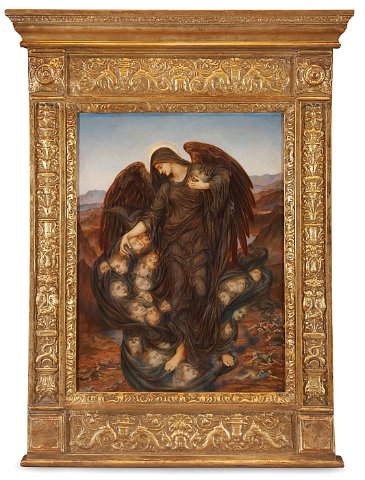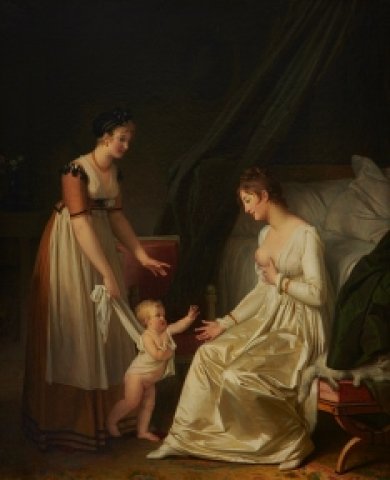Clark Art Institute Announces Acquisitions
Two by Marguerite Gérard and One by Evelyn De Morgan
By: Clark - Mar 29, 2023
The Clark Art Institute recently added three new paintings to its permanent collection, enhancing its holdings of works by women artists. The paintings, two by Marguerite Gérard and one by Evelyn De Morgan, are the first by either artist to enter the Clark’s collection.
“Working more than a century apart, Marguerite Gérard and Evelyn De Morgan used their paintings to reflect on the lives of women and the politics of their days,” said Esther Bell, Deputy Director and Robert and Martha Berman Lipp Chief Curator of the Clark. “We are making a concerted effort to expand the Clark’s permanent collection to include artists who have not received the attention they so richly deserve. We are delighted to introduce these talented artists to our visitors and add their voices and perspectives to the stories we share in our galleries.”
The Clark acquired two companion paintings by Marguerite Gérard, The Nursing Mother (La Mère nourrice) and The Capricious Child (L’enfant capricieux). The paintings, both executed in 1804, have been in private hands for more than 200 years and have not been exhibited publicly since the early nineteenth century.
|
|
|
The sensitively rendered paintings were exhibited as pendants in the Salon of 1804 in Paris and earned Gérard the Médaille d’Or (gold medal) for artistic achievement. The superb examples of the painter’s intimate interiors meticulously present domestic narratives, with The Nursing Mother depicting a caretaker supporting a child as he eagerly toddles towards his mother who extends her hand and waits to nurse him. In The Capricious Child, a child stubbornly turns away from his mother, refusing to leave the arms of his wet nurse. In that time, Gérard’s paintings actively stimulated debate and conversation around women, breastfeeding, and motherhood. Viewed alongside one another, the paintings offer alternate visions of motherhood, with The Nursing Mother representing the ideal or bonne mère and The Capricious Child the unideal or mauvaise mère.
Gérard’s painterly skill is evident in the subtly blended brushstrokes and painstakingly realistic fabrics and household objects. In The Nursing Mother, Gérard’s luminous treatment of the mother’s satin gown especially recalls the paintings of the Dutch masters she admired, notably Gabriel Metsu and Gerard ter Borch. The domestic details were praised by a salon critic who paid special attention to the cat peeking out from under the bedding in The Nursing Mother, writing that it had “tout le mérite qu’on peut désirer dans ces sortes d’accessoires.” [all the merit that one could desire in this type of accessory] (Journal des Débats, 1804).
Scholars have suggested that Gérard’s brother-in-law, the noted French painter Jean-Honoré Fragonard, may have collaborated on The Capricious Child, with the addition of the boy. The two artists are known to have worked alongside one another on occasion. The Clark will undertake further examination to substantiate this assertion.
Evelyn De Morgan’s painting, The Field of the Slain, is a gripping response to the devastating news arriving in England from the battlefields in Belgium and France during World War I. A staunch pacifist, De Morgan organized an exhibition in the spring of 1916 of thirteen paintings created over the previous two years. The paintings were not for sale, and instead the admission fees benefited the British Red Cross and the Italian Croce Rossa in the two nations’ war relief efforts. Any visitor to the exhibition would have understood the overt symbolism of the work, whose catalogue entry read: “The Angel of Death is gathering up the spirits of the slain; they have been robbed of their earthly-life and are young and undeveloped.”
With an effervescent palette of aubergines, crimsons, and blues, De Morgan achieves an otherworldly aura. Her virtuosic treatment of the angel’s drapery, a rippling gossamer cloak, reflects her admiration for the masters of the Italian Renaissance, whose paintings she studied during her many sojourns to Italy. The angel rises above a desolate brown landscape, recalling the trenches of war, and tenderly collects the souls of the slain. Their souls appear as disembodied heads gathered in the sculptural folds of the angel’s drapery.
De Morgan’s choice to represent the moment that the souls of the dead are being taken from the corporeal realm into the spiritual realm reflects her Spiritualist beliefs. Spiritualism, popular among the pre-Raphaelites, advanced a belief in the continuity of consciousness after death and in the possibility of communicating with the dead, a practice in which De Morgan herself engaged. Here and in several of her paintings, De Morgan represents humankind lost prematurely to war.
The Field of the Slain is emblematic of De Morgan’s lifelong beliefs and is a haunting testimony to this particular moment in history.
Upon viewing this painting when first exhibited in 1916, Felix Moscheles, a senior member of the International Peace Bureau and President of the International Arbitration Association, wrote in a letter to De Morgan:
“I came—I saw—and you conquered! Once more I am fully impressed by the loftiness of your conceptions which pervade all your work, and by the masterly execution which enable you to give concrete form to your abstract ideals. Your drawing severely discards the non-essential and your colours are merged like those of the rainbow that promises peace and harmonies. Recalling your pictures I seem to hear your triumphant Angels singing Hallelujah! As they repulse my well-hated enemy, the Demon of War.”
ABOUT MARGUERITE GÉRARD
Following her mother’s death in 1775, Marguerite Gérard (French, 1761-1837), left Grasse in Southern France to join her elder sister, Marie-Anne Fragonard, and her sister’s husband, Jean-Honoré Fragonard, in their quarters in the Louvre in Paris. Marguerite Gérard would live and work there for the next thirty years.
As a woman, Gérard was excluded from formal training and exhibition at the Académie royale de peinture et de sculpture, which allowed for only four women members at a time (the seats were then occupied by Adelaide Labille-Guiard, Anne Vallayer-Coster, Elisabeth Vigée-Lebrun, and Marie-Thérèse Reboul). Instead, she became an informal apprentice to her brother-in-law, Fragonard, one of the most celebrated painters of the Rococo, and she studied the numerous paintings available to her in the royal collection. Especially inspired by the Dutch masters of the seventeenth century, she developed her own style of genre painting and achieved both critical success and financial stability. After the Revolution, women were granted permission to participate in the Salons, and Gérard exhibited frequently between 1799 and 1824—winning three medals.
Long neglected in scholarship, and undeniably overshadowed by her brother-in-law, Gérard has recently begun to receive her due thanks to the efforts of scholars Sally Wells-Robertson, Jean-Pierre Cuzin, and Carole Blumenfeld. Gérard is now rightfully becoming recognized as one of the most accomplished painters of her time.
ABOUT EVELYN DE MORGAN
Mary Evelyn De Morgan (British, 1855-1919) was determined to become an artist. In 1873, at the age of eighteen, she registered at the Slade School of Art in London, where women had only recently gained admission. There she studied under Edward Poynter, though her style and ambition would soon surpass that of her instructor. It was through the mentorship and support of her uncle, the celebrated Pre-Raphaelite painter, John Roddam Spencer Stanhope, that De Morgan would become introduced to the art of the Pre-Raphaelite circle. She began exhibiting her works in London in 1887, notably at the Grosvenor Gallery and the New Gallery, and she would remain active in the public artistic sphere throughout the remainder of her life.
De Morgan was active in the British suffragette movement, signing the Declaration in Favour of Women’s Suffrage in 1889. Her progressive political activities evolved into pacifist beliefs as she witnessed the devastation wrought first by the Boer War, and then by World War I. She lived to see the end of fighting and an armistice signed on November 11, 1918, although she did not survive to see the final signing of the Treaty of Versailles on June 28, 1919.
Images: Marguerite Gérard, The Nursing Mother (La Mère nourrice), 1804, oil on canvas. Clark Art Institute, Acquired by the Clark, 2022.16; Marguerite Gérard, The Capricious Child (L’enfant capricieux), 1804, oil on canvas. Clark Art Institute, Acquired by the Clark, 2022.15; Evelyn De Morgan, The Field of the Slain, c. 1914-16, oil on canvas. Clark Art Institute, Acquired by the Clark, 2022.14



